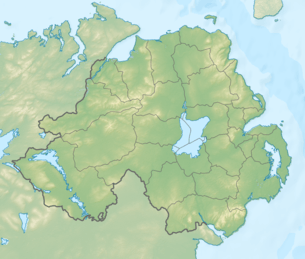Dungannon land mine attack
The Dungannon land mine attack was an Improvised explosive device attack and shooting against a British Army mobile patrol. The attack was carried out by IRA volunteers from the Provisional IRA's East Tyrone Brigade on 16 December 1979, along the Ballygawley Road, just outside Dungannon in County Tyrone. Four British soldiers who were on mobile patrol were killed in the ambush.[1]
| Dungannon land mine attack | |||||||
|---|---|---|---|---|---|---|---|
| Part of the Troubles and Operation Banner | |||||||
| |||||||
| Belligerents | |||||||
|
East Tyrone Brigade | |||||||
| Strength | |||||||
| 1 active service unit | 1 mobile patrol | ||||||
| Casualties and losses | |||||||
| None |
4 killed 1 vehicle destroyed | ||||||
 Location within Northern Ireland | |||||||
Background
After decreasing violence in 1977 and 1978, there was an upsurge of armed incidents in 1979 in Northern Ireland, with the Provisional IRA beginning its "Long War" offensive. 1979 became the worst year for British Army and RUC killings in Ireland since 1974. On 27 August the IRA carried out the Warrenpoint ambush in south County Down near the border, the roadside bomb attack killed 18 British soldiers and injured six others, it was the heaviest loss the British Army suffered at the hands of the IRA during the whole conflict.[2][3]
Attack
On 16 December 1979 an IRA active service unit from the East Tyrone brigade set up a landmine under a culvert along the Ballygawley Road, just outside Dungannon. The land mine was detonated by the IRA unit using a wireless remote controlled device to activate the detonator as a British Army mobile patrol passed in a landrover, the hidden land mine under the culvert blew the landrover the soldiers were travelling in into the air. The landrover was the second in a patrol of two landrovers with four soldiers in each vehicle. Shots were fired by the IRA at the first landrover and the landrover returned fire, there was no hits on either side.[4][5] Four British soldiers, William Beck (23), Keith Richards (22), Simon Evans (19) and Allan Ayrton (23) were all killed instantly. They had only been serving with the 16th Regiment Royal Artillery in Northern Ireland for two weeks. [6][7][8] The land mine was estimated to have contained between 800–1,000 lbs of explosives in it.
Aftermath
On the same day as the Dungannon attack the IRA's South Armagh Brigade killed another British soldier in a booby-trap bomb attack in Forkhill, County Armagh. They also shot dead a former UDR soldier in Omagh [9][1] Bringing the total dead to six British soldiers on the day.
In the following years, the area around Ballygawley became a death trap for British forces. On 13 July 1983 four UDR soldiers were killed in the Ballygawley land mine attack, at the time it was the worst attack the UDR suffered.[10] On 20 August 1988, eight more British soldiers were killed and 28 others badly wounded in an IRA bombing of a British military bus on the same road.[11]
See also
References
- "CAIN: Sutton Index of Deaths". cain.ulster.ac.uk. Retrieved 2019-01-26.
- "CAIN: Sutton Index of Deaths". cain.ulster.ac.uk. Retrieved 2019-01-26.
- Peter Taylor - Behind The Mask: The IRA & Sinn Fein pp.266
- "Gunner Alan David Ayrton, Gunner William John Beck, Lance Bombardier Keith Charles Richards, and Gunner Simon Peter Evans". British Armed Forces The Best|Home. Retrieved 2019-01-26.
- "Northern Ireland (terrorist activities) (Hansard, 17 December 1979)". api.parliament.uk. Retrieved 2019-01-26.
- "Gnr Simon Evans". www.pro-patria.co.uk. Retrieved 2019-01-25.
- "Palace Barracks Memorial Garden - Northern Ireland, Falklands Islands, Felix Memorial Garden". www.palacebarracksmemorialgarden.co.uk. Retrieved 2019-01-25.
- "Five soldiers die in Ulster bombing". Daily Mirror. 17 December 1979. Retrieved 25 January 2019.
- "CAIN: Chronology of the Conflict 1979". cain.ulster.ac.uk. Retrieved 2019-01-26.
- "CAIN: Sutton Index of Deaths". cain.ulster.ac.uk. Retrieved 2019-01-26.
- "CAIN: Chronology of the Conflict 1988". cain.ulster.ac.uk. Retrieved 2020-02-05.